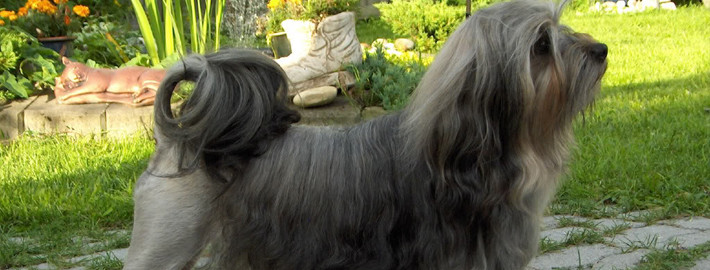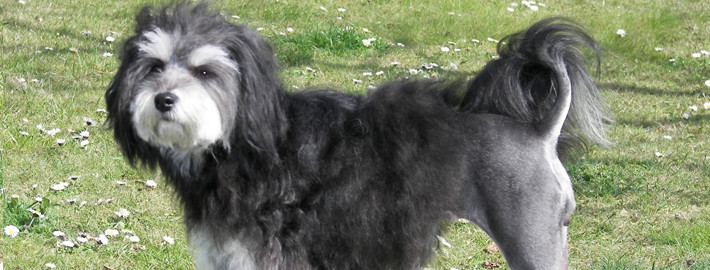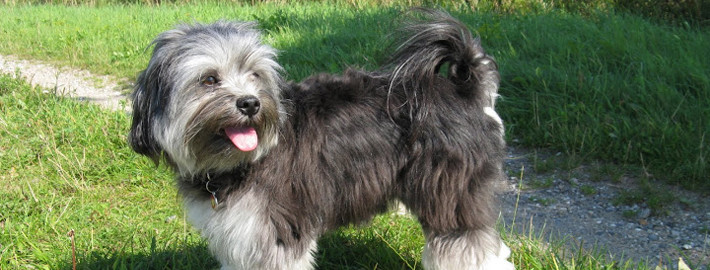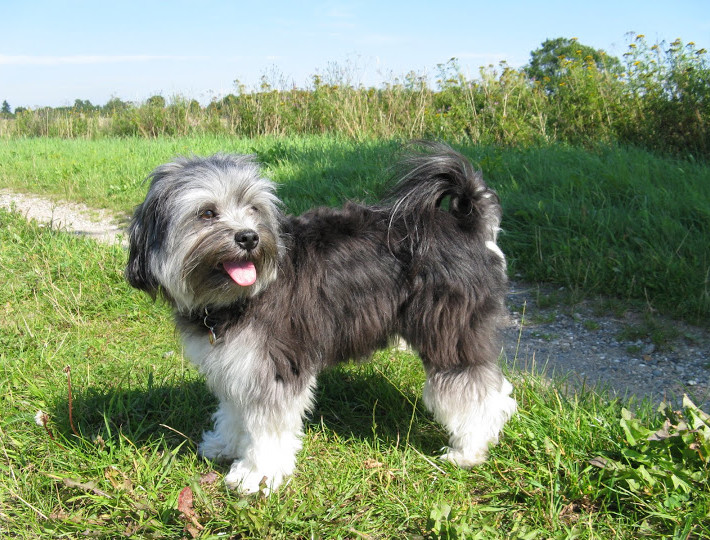What makes the Lowchen Unique?
The lowchen is a compact small dog, very slightly longer than it is tall, with strong, sturdy — but never coarse — bone. Its gait is effortless with good reach and drive, and it proudly carries its head and tail. Its coat is dense and long, moderately soft with a slight to moderate wave. It is traditionally clipped in a lion trim. The lowchen has a relatively short, broad top skull and muzzle, and its expression is alert, bright and lively. This is a lively, inquisitive, affectionate dog. It is a mixture of playful spirit and calm soul mate, a good companion for a quiet family. It is willing to please and responsive to commands, and it is devoted to its family. Some may bark or dig a lot.
Page Contents
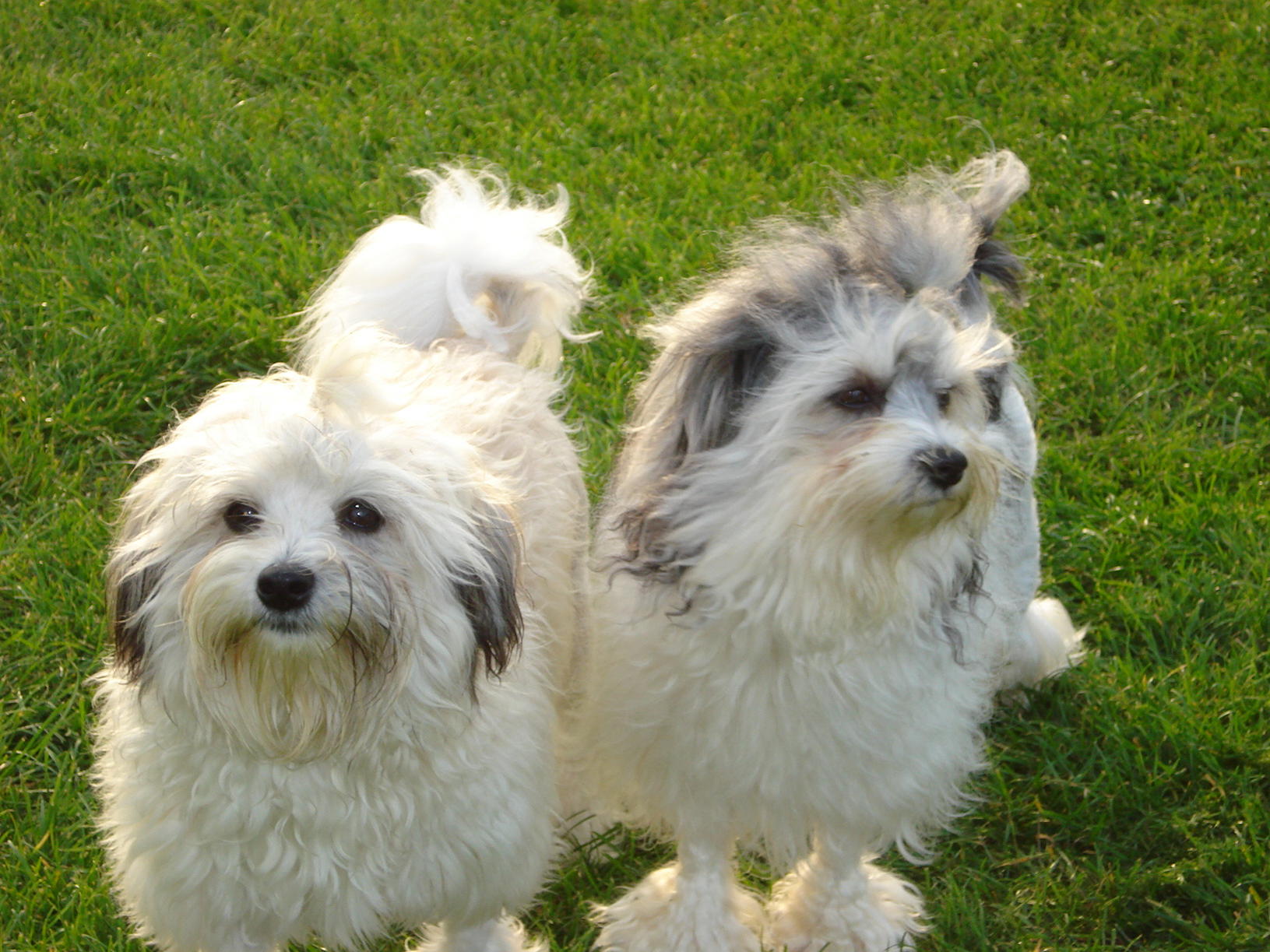
Is the Lowchen Right For You?
The Löwchen’s outgoing and positive attitude make the breed a pleasure to be around. As a companion dog, they are affectionate and like to be with their families. Although smaller in size, they enjoy daily walks or other activity. Their single coat needs a thorough brushing at least weekly to prevent matting and their trim should be freshened every two months. If you are considering purchasing a Löwchen puppy, learn more. *Non-Sporting Group; AKC recognized in 1996.
*Ideal size: 12 to 14 inches tall at the shoulder.
*Companion Dog.
In 5 Words
- Playful
- Familial
- Happy
- Friendly
- Active
Characteristics
Learn About the Lowchen
Description
The Löwchen’s coat is long and flowing and comes in many colours. The coat should not be thin and fluffy like a Bichon Frise, but wavy with a mix of thicker hairs amongst the fine ones. This allows for a flowing coat that is not frizzy or fly-away, and a Löwchen coat should not be harsh like many terriers. The Löwchen does not shed, and this breed has very low allergic effects, and are considered hypoallergenic.[2] The head of the Löwchen is one of its most important features, with its relatively short, wide muzzle, broad skull, lively round eyes, and pendulant ears. They can come in all colours, including brown, that allow for dark eyes and nose. The head, when in proportion to the body, is neither too big nor too small, but helps to emphasize the friendly, regal, and leonine personality of the Löwchen.
Short History of the Lowchen
Lowchens were first depicted in art dating back to the early medieval period, when they likely emerged as a separate breed. There is some debate as to whether they originated in Germany or Italy, but it seems they were common in European courts by the 15th century.
It is believed they gained their traditional styling in the Florentine court where a fascination with “The Orient” caused them to have them shorn up to look like little Chinese lions.
Their docile manner and loyalty to human owners is legendary. There is an apocryphal story that has a Lowchen known to history as Bijou jumping out the top tower of a German castle when his mater went out on hunt without him. True or not, Lowchen developed a reputation as a good dog for the wealthy to keep as a constant companion.
More recently, the breed was popular with well-off European men and women of the 18th and 19th centuries, with particular popularity among the emerging middle class of Central Europe. However, in the 20th century, the popularity of the animal declined as modern ideas were adopted in all aspects of human life. During World War Two the breed was nearly exterminated, with only a few individual dogs remaining. Lowchens were even listed in the Guinness Book of World Records as the World’s Rarest Breed of Dog in the 1960s.
Temperament
These dogs are, above all else, loving and affectionate. They are also clever and cautious. Lowchens are usually relaxed, even around other dogs-able to perk up and play when the opportunity presents itself. However, the poorly socialized dog differs from the well-socialized one by being snappy and yipping with a piddling problem.
They’ve been selected for several centuries as the companions of ladies at court and in that environment of constant care and attention, are almost always docile unless playing around. Since they are also tough and proud (for their size), Lowchen males tend to be alpha dogs, even in a house with other large dogs.
With affection being so paramount in the mind of most Lowchen, they are far less interested in protecting you from strangers as getting attention from them, in the hopes you’ll all become friends and decide to pet the dog. Be careful with young pups to minimize separation anxiety. They are best suited to people who work at home or can take them to work with them.
They are good with older children and parties, though young children should not be left alone with the dog, since they’re so small and could be hurt easily. Be careful of situations with people who think your dog is a toy and treat it as such-he or she is still a dog. Lowchens will defend themselves if the danger seems mortal. If you were less than a foot tall, you’d be nervous, too.
Though they’re not usually hyperactive, they can present some trouble with barking and digging. This is often taken care of with attention and exercise, tough a particularly headstrong specimen may take some patient training. This is especially true of the barking. Lowchen feel it’s their duty to announce any activity, no matter how small.
They take readily to training and are usually quick studies with housebreaking and simple commands. They are very anxious to please their masters and make no differentiation between good and bad masters. Males can be wilful at times, though ignoring them is often the worst punishment you can dole out-use it carefully.
The Lowchen is very rarely angry and only shows aggression when trying to assert him or herself over larger dogs. Their behaviour towards humans is almost always friendly and happy.
Caring for Your Lowchen
General Health
All dogs have the potential to develop genetic health problems, just as all people have the potential to inherit a particular disease. Run, don’t walk, from any breeder who does not offer a health guarantee on puppies, who tells you that the breed is 100 percent healthy and has no known problems, or who tells you that her puppies are isolated from the main part of the household for health reasons. A reputable breeder will be honest and open about health problems in the breed and the incidence with which they occur in her lines.
Fortunately, the Lowchen is a pretty healthy little dog. Potential health problems include a knee condition called patellar luxation and eye problems such as cataracts and progressive retinal atrophy
Grooming & Bathing
The non-shedding coat is soft, silky and may have a slight wave.Do they shed?The Lowchen is an ideal dog for people who suffer from allergies or asthma, as they do not shed. They have a very soft non-oily coat that does not collect dirt or pollens. However for every up side there is the down!Grooming:”Do they grow that way?” Folks are inclined to ask of the leonine look sported by the breed. The answer is “no.” They’re clipped to resemble miniature lions but, unlike the Poodle, the unclipped portions are not trimmed or shaped but left shaggy and natural. Is their coat difficult to maintain? The Lowchen hair readily turns to dread knots (mats) if left unattended. They must be treated like one of your children – one that never grows up and learns to comb their own hair! They need a quick comb daily or a thorough combing after their weekly bath. They are only a foot off the ground so they will get wet and dirty easily – hence the need for the regular bath (especially if you suffer from allergies). A fifteen-pound dog that fits into the kitchen sink is not difficult to bath. Keeping the dog clean and the hair well conditioned will help eliminate any reactions. If kept in the traditional lion clip, all of the ‘dirty’ hair is removed and you have half the coat to brush. However, many pet owners are not attracted to the show coat and prefer to keep their Lowchen is a ‘puppy’ cut. Regardless of the trim, the Lowchen coat will need to be groomed every four to six weeks.Colour:All colours or combinations of colours are accepted. All patterns of white are found as well as Lowchen with no white at all. And to keep things interesting, most, but not all, Lowchen tend to change colors over the first few years fading and then darkening back up to a new shade!
Exercise & Training
Though they don’t often require much, most Lowchen will happily take all the exercise you can provide, being especially fond of long walks. Never one to back down from a challenge, they’ve even been known to go along on very strenuous hikes and runs with their human pack. As long as they’re with people, they don’t seem to care how tired they may be.
Regular walks and visits to the park are usually enough to keep a typical Lowchen healthy and happy. They may be taken off leach, as they usually mind well when properly trained, but may be in danger from some larger dogs.
Like many other small dogs, they don’t seem to realize how small they are and, will attack even very large dogs for no apparent reason other than to prove they’re real dogs and not wind-up toys. It might be best to be careful at dog parks where there are a lot of big dogs for your Lowchen to pick a fight with. The key with the Lowchen is to keep it under your constant gaze while a puppy. When you see a behaviour you don’t like, you must let him or her know immediately that you don’t like it. Because the bond that develops is so close, this can be as little as a stern look or whatever word you choose to mean you’re not happy.
Punitive measures are not necessary for the most part and they should feel bad enough when you let them know they’ve been spotted, as long as you do it every single time and within moments.
Consistency is paramount. Though the dog can escape and piddle on the floor anywhere in the house and not get punished for it, you’ll need to make sure your Lowchen doesn’t have the chance to do so. Most trainers recommend using a crate for the first few months of life to make sure the housebreaking never becomes an issue.
In fact, it’s best you use positive reinforcement with your dog if at all possible. They are usually gentle creatures themselves and really want to be happy as much as possible. Their love of a good time makes them particularly easy to manipulate into a well-rounded companion you can take with you just about anywhere.
It is also vitally important you socialize your dog early on to minimize the fear some lines of this breed are prone to. Dogs who aren’t well socialized can become distrustful and angry – even snapping at people who try to touch it that he or she doesn’t already know well.
Meeting other dogs and people will not only get them accustomed to contact, but also exposes them to new ideas and situations that stimulate intelligence in the growing puppy brain.

